Development Projects Featuring “Resilience” to Climate Change (Pt 2)

Pt 1 on the subject, a couple weeks back, was about The Wharf, a 24-block resilient development along 1 mi. of Washington, DC waterfront.
Today: Harvard’s Spaulding Rehab Hospital, located in the Inner Harbor of Boston. And, a late addition of related interest.
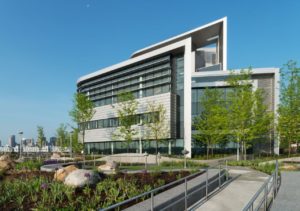
Spaulding, set in Boston’s former Charlestown Navy Yard and opened in 2013, is designed for 4 days of “island mode” operations. All of the mechanical equipment, and the 13k volt electric switch-gear/service (drawn through a concrete chase) is located on the roof of the 9-story $225m building. Overall, it’s reported that resilence-programmed design and construction added about $1.5m to total development costs.
Designed by Perkins+Will, the 1st floor of the building is 30 in. above the 500-yr. flood elevation, keeping water out even during a catastrophic flood. A flooded 1st floor would not affect ongoing hospital care operations on the floors above.
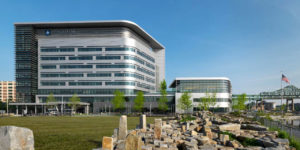
Large blocks of granite discovered during site excavation have been repurposed as berms arranged to direct floodwaters from Boston Harbor and the Little Mystic River away from the property. Rapid site drainage from flooding has also been designed into the waterfront landscaping.
Another important concept of resilience, sheltering in place, is provided through keyed, operable (triple-glazed) windows that also afford significant daylighting. Another is a very high level of building insulation throughout. It’s reported that the energy EUI (energy use intensity) of the 262,000 sf, 132-bed hospital is 150 Btu/sf/yr. That’d be about half of that of the average American hospital.
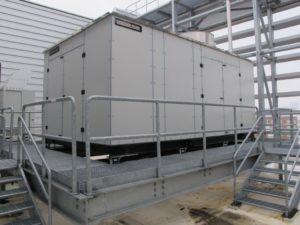
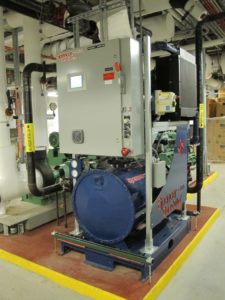
Co-generation on-site provides about 25% of the building’s power needs, aimed at peak demand periods. Captured waste heat is used for water heating and other sues.
Power redundancy is provided by 2 rooftop back-up diesel generators which can power certain operating requirements for at least 4 days; or longer if electrical loads can be dialed back. The fuel tank and pump, located in the basement, are encased in a submarine-like bunker.
From the most recent presentation on Resilience attended (I walked a few blocks from my office to attend this one on the M.I.C.A. campus) came some knowledge about a fascinating project for Staten Island, NY. Daunting engineering, for one. Watch for it soon.
Return to Old Stomping Grounds for a Look at Flood Mitigation Devices–
In Annapolis, city officials are considering flood mitigation devices to protect its historic City Dock area. Unlike new construction projects or a singular major renovation of an existing property where a business/es operate, the historic City Dock is populated by scores of mom-‘n-pop retailers, museums, restaurants, the Market House, a hotel and several B&Bs, and some retail or restaurant chains. Hard to elevate streets of ’em to storm surge and projected sea rise levels due to global warming.
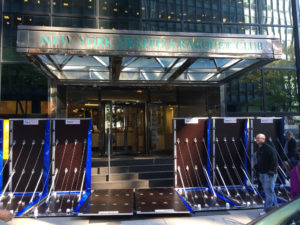 AquaFence USA is one of two companies recently invited to demonstrate their mobile fence protection product.
AquaFence USA is one of two companies recently invited to demonstrate their mobile fence protection product.
The Capital‘s Chase Cook wrote: “The fence is a raised structure of varying heights [4′-8’] and a base that sits underwater. The weight of the water on the base prevents the forward momentum of the water from pushing over the fence, company officials said. And each plate is interlocked to the other with tarps that make it possible to shift and shape the fence as needed.
“Constructed of marine grade laminate, stainless steel, aluminum and reinforced PVC canvas, AquaFence systems become stronger as floodwater pressure is applied.” (Source: company’s website.)
The other company is U.S. Flood Control Corp. which displayed its TigerDam product.